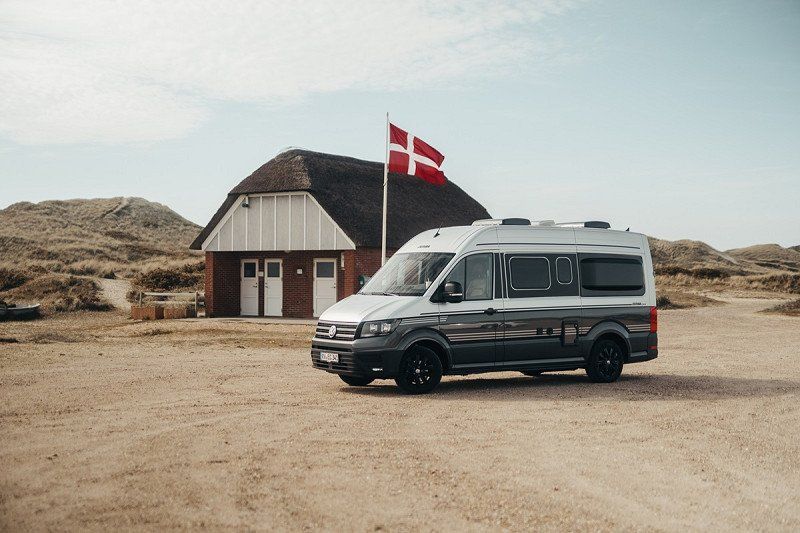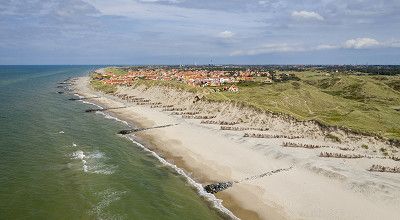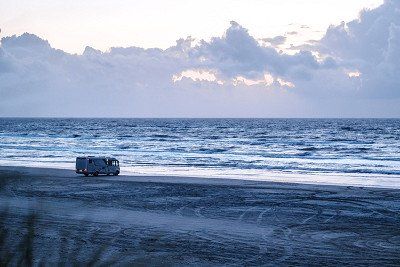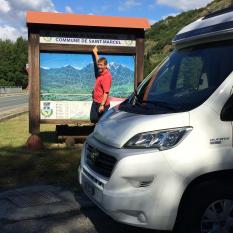Latest update: March 26, 2025
Table of contents
Entry to Denmark
The dog law in Denmark
The main traffic rules for motorhomes and caravans in Denmark
Information about the toll in Denmark
Petrol stations - opening times and means of payment in Denmark
General traffic rules in Denmark
Important addresses and telephone numbers for holidaymakers in Denmark
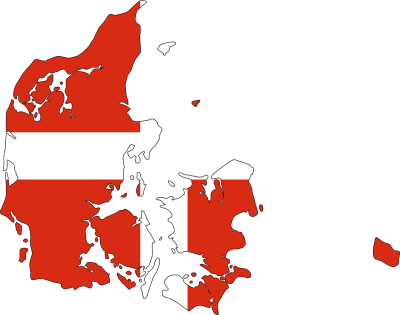
Entry to Denmark
Entry requirements for EU citizens:
For a tourist stay, EU citizens need a (provisional) passport or (provisional) ID card or a child's passport when entering the country. Random border checks may be carried out when entering Denmark from Germany or Sweden. Only a passport is accepted for entry to Greenland.
Entry of children to Denmark:
If you travel with minors under the age of 18 of which you are not the legal guardian, for example friends of your own children, you should carry an officially certified declaration of consent from a legal guardian. Children also need an identity card or passport.
Entry of pets to Denmark: EU regulations apply to the entry of pets into Denmark. Dogs, cats and ferrets must meet the following requirements: If a dog, cat or ferret is imported to Denmark from an EU country, it is very important that the animal is identifiable - either by a chip or by a legible tattoo (e.g. an ear tattoo). The microchip is mandatory for animals that have been labeled for the first time after July 3, 2011. In addition, an EU pet passport issued by a veterinarian must be carried for the animal. It needs to state a proof of a valid rabies vaccination. It is important that the last vaccination or re-vaccination is not older than the tattoo or the insertion of the chip. A new vaccination must have been carried out at least three weeks before entry.
It is also important to note that if the pet is not accompanied by the owner or by someone who is responsible for the pet on behalf of the owner, the import is considered a commercial import.

Special rules for the Faroe Islands and Greenland: Holiday makers and tourists are generally not allowed to take their pets to the Faroe Islands. Only people who either intend to settle on the Faroe Islands or who already live there can, under special conditions, obtain permission for a permanent import of a pet.
The following applies to Greenland: Dogs can be brought into the municipalities of Ivigtut, Manütsoq, Nanortalik, Narsaq, Nuuk, Paamiut and Qaqortoq. A rabies vaccination must be carried out at least 30 days and a maximum of 12 months before the import. Timely vaccination is immediately valid, but evidence of previous vaccinations must be shown. In addition, a health certificate (La23.0-783.1a) must be presented and treatment for tapeworms must be documented at least 14 days before import. In addition, the animal must not have been in contact with other animals from the time the health certificate was issued until it was imported into Greenland (isolation). Dogs must also have been vaccinated against canine distemper and canine parvovirus. Females also need to be sterilized. If you stay for a maximum of 3 months, “sterilization” by medical treatment is permitted.

The dog law in Denmark
At the beginning of the 2000s, there has been a lot of discussion around dog legislation in Denmark, which says dogs should be put to sleep if they attack a person or another dog and cause bite injuries. This law still applies, but was revised on July 1, 2014 with a more precise definition of such bite injuries. This is supposed to offer holiday makers with dogs more security in case any bite injuries should occur "within the normal behavior of a dog". The exact provisions are explained on the website of the Danish Ministry of Environment and Food . There is also detailed information on the entry of the so-called list dogs of the following 13 breeds: Pit Bull Terrier, Tosa Inu, American Staffordshire Terrier, Fila Brasileiro, Dogo Argentino (Argentine mastiff), American Bulldog, Boerboel, Kangal, Central Asian Owtscharka, Caucasian Owtscharka, South Russian Owtscharka, Tornjak and Šarplaninac. These breeds are not allowed to enter Denmark unless it is a mere transit. For all dog breeds or mixed breeds that are similar to one of the breeds mentioned above, it is definitely advisable to carry documents stating the breed of the dog. With mixed breeds, however, this is likely to be difficult.
Other regulations for dogs in Denmark
No more dog bans in restaurants: For a long time, there was a general ban on dogs in catering establishments in Denmark, but this has now been lifted. Now restaurant and café owners can decide for themselves whether dogs are welcome or not. Exceptions are guide dogs and assistance dogs.
Leash requirement: Having your dog on a leash is mandatory on the beaches in Denmark between April 1st and September 30th. In forests even all year round.
The main traffic rules for motorhomes and caravans in Denmark
Speed limits on Danish roads for cars, campervans and motorhomes
In the event of speeding violations, fines from 135 euros apply at 20 km / h above the speed limit and from 300 euros at 50 km / h above the speed limit.
Further regulations for caravan combinations
The breakaway cable must be attached to an eyelet on braked trailers.

Information about the toll in Denmark
The good news is that there are no tolls in Denmark on public roads and highways. However, there are two bridges where you have to pay for the use: the Great Belt (Storebaeltsbroen ) bridge between Knudshoved (Funen Island) and Halsskov (Zealand Island) and the Oresund Bridge between Copenhagen-Kastrup and Malmö-Lernacken in Sweden. The tariffs depend on the type of vehicle and the length of the vehicle. Motorhomes are charged according to the total length in the categories from 6 m and from 10 m. For caravan combinations, the prices are based on the length of the trailer up to 15 m and from 15 m and on the length of the towing vehicle under 6 m and over 6 m respectively.
The crossing of the Öresund Bridge costs for cars, caravans and motorhomes up to 10 meters between about 61 euros and 123 euros per one-way trip without a so called ØresundGO subscription (prices as of March 2025). The charges for the Storebaelt Bridge were significantly reduced at the beginning of 2025 due to an EU regulation. At the Storebaelt Bridge, the charges for a single journey with a car, caravan or motorhome now range from approx. 31 euros to approx. 47 euros depending on length and weight (as of March 2025). The fees are paid on site in cash or by credit card. However, the Öresund Bridge offers the option of purchasing online tickets in advance, which are then slightly cheaper. The discounted prices listed for the Storebaelt Bridge on their website only apply to vehicles registered in Denmark.
Petrol stations - opening times and means of payment in Denmark
There are fewer petrol stations in Denmark than e.g. in Germany. It is therefore advisable to fill up when the opportunity arises. There are 24-hour petrol stations on the motorways and in major cities, otherwise the opening hours during the week are between 6:00 a.m. and 10 p.m. and on weekends between 7 a.m. and 9 p.m. Many petrol stations have automatic dispensers and usually only little staff. But don't worry: Instructions on the machine are always available in English as well. The general rule is: pay first and then fill up! You can usually pay by credit card with pin code, sometimes even in cash. Some petrol stations and automatic dispensers also accept Maestro cards.

General traffic rules in Denmark
Compulsory daytime running lights:
In Denmark there is a light requirement all day and all year round. So always remember to turn on your headlamps or daytime running lights.
Drink-drive limit:
The alcohol limit in Denmark is 0.5 ‰. Violations are not punished with a uniform fine, but the sum is calculated individually. For this purpose, the amount of blood alcohol will be multiplied with the respective monthly net income. So this could become rather expensive! Also: If the blood alcohol level exceeds 2 ‰, your car will be confiscated and then auctioned off. The proceeds will then go to the Danish state treasury.
Child safety car seats:
In Denmark, children shorter than 135 cm must travel in a child safety car seat or on a special booster seat.
Safety vests:
There is no statutory safety vest obligation in Denmark, but it is recommended that you carry safety vests in the event of a breakdown or accident.
Marking of protruding cargo:
Protruding cargo (such as a bicycle rack) may protrude a maximum of 1 m at the front and rear and a maximum of 15 cm at the side of the vehicle. If the load exceeds these dimensions, it must be labeled. A warning sign is recommended, but not a requirement. Instead, the load can also be marked with a conspicuous cloth or flag; in the dark, the load must be marked with a white light to the front and a red light to the rear. Including cargo, a vehicle must not be wider than 2.55 m, no longer than 12 m and no higher than 4 m. In case the lights or the license plate are covered by the cargo, they must be visibly attached in another way.
Telephoning while driving:
The mobile phone may only be used in the vehicle with a hands-free device for telephone calls and for navigation.
Wild camping / free standing:
Unlike in Sweden, Norway and Finland, there is no everyman's right in Denmark. This means that you are not allowed to pitch your tent just anywhere in the countryside in Denmark. Also motorhomes and caravans are not allowed to stand free at will. However, you are allowed to spend the night at official rest areas to restore your fitness to drive, unless it is expressly forbidden. The prerequisite here is that all camping accessories remain inside the camping vehicle.
In return, however, Denmark offers a good infrastructure of campsites. In addition, an increasing number of motorhome pitches have been set up in recent years, often in the immediate vicinity of the campsites. In addition, numerous farms now offer private motorhome pitches. However, it should be noted that even on the popular car beaches in Denmark, cars and motorhomes are only permitted during the day. Overnight stays on the beach are not permitted in camper vans or tents.


Important addresses and telephone numbers for holidaymakers in Denmark
European emergency number: 112
You can get help from the local police, fire brigade, an emergency doctor or ambulance via this central emergency number, which can be reached free of charge via the fixed network or by mobile phone without a code.


